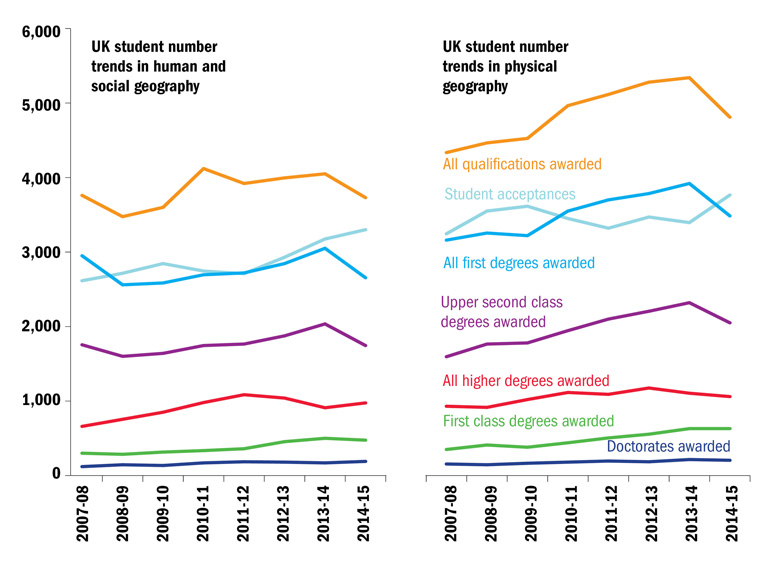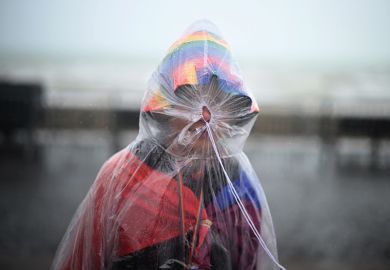‘The great challenges of the 21st century are geographical in their formulation, analysis and consequence, and they transcend the physical/social divide’
To study the Earth, its biodiversity and humans as part of that, is to study geography.
A few decades ago, our discipline was in the academic doldrums. Split between the science of the physical world and the social science of humanity, it was accused of being a subject without a core: no more than a bunch of disparate interests and maverick academics gathered under the banner of place and space, teaching undergraduates of middling ability who were often set on a career in banking.
In the UK, the phrase “geography teacher” remains a term of abuse. It has been used to disparage the manners, attitudes and even sartorial elegance of individuals as disparate as Labour Party leader Jeremy Corbyn and musician Jarvis Cocker. Yet geography has never been more important than it is now. Humans have never been more networked, and we have never known so much about the natural world, its biodiversity, its chemistry, the flows of its energy that we capture and put to work and the consequences of our actions on a dynamic biosphere. The linking of all these things is the essence of geography, and the subject is enjoying a renaissance.
In 1971, US biologist Barry Commoner set out four laws of ecology in his book The Closing Circle: Nature, Man and Technology. These were: everything is connected to everything else; everything must go somewhere; nature knows best; and there is no such thing as a free lunch. Some might think this is all rather New Age and glib, but unpick these simple homilies and you reveal the origins of modern geography. It is indeed a scavenger discipline, picking up ideas from fields as diverse as ancient philosophy and modern biology and sticking them together. But connections lie at the heart of globalisation; nature is at the root of sustainability; and that lack of a free lunch is linked to the importance of equality.
This is because our well-being is based on mutual interdependence with each other and with the natural world. When the comparator countries’ overall levels of affluence are similar, people in more equitable countries tend to consume and pollute far less than they do in those where inequality is higher. If everyone on earth behaved, consumed and polluted like the citizens of the US, we would need four planets to live on. If we all lived as the far more equitable and ecological Japanese live, then we would need only two. Unfortunately that is still one planet more than we have.
Those three core concepts – globalisation, sustainability and equality – sit at the heart of 21st-century geography. This is arguably true regardless of whether it is focused on the physical processes of the natural environment or the less predictable complexity of human lives, states, wars and trade. These are the three areas of knowledge – conjoined with a humanistic philosophy – that acknowledge the pre-eminence of physical constraints on human endeavour. The future of geography includes developing a toolbox for transformative change. It is an action subject: geographers not only do fieldwork, they also become involved in activism, policy and advocacy.
The great challenges of the 21st century are geographical in their formulation, analysis and consequence, and they transcend the physical/social divide. These include climate change; accommodating 10 billion humans (which means coping with population ageing); maintaining biodiversity (slowing the rate of extinctions); enabling food production to rise (and eating less meat); managing increasingly diverse and growing urbanisation (and diaspora); and understanding the globalised flows of capital that undermine the concepts of the nation-state and democracy.
Geography has always been at the heart of trying to understand both the world humans inhabit and what it is to be human. Literally meaning Earth-writing, it is much older than the ancient Greeks who coined that term. It stretches from the earliest cave paintings depicting the animals that roamed the world and the very first field systems, to the design of new warped maps of our modern world: highly detailed gridded cartograms that portray the incidence and distribution of populations, their habits and their environments.
In Europe, we still remember Thales of Miletus, the philosopher and mathematician who, in the 6th century BC, used trigonometry to calculate distance and height and strove to explain the natural world without recourse to mythology. Today, we are learning (many of us for the first time) that a long geographical tradition was being developed in China at the same time. Gridded maps and complex inventories of places and resources – and the connections between them – were increasingly important knowledge for successive centralised Chinese states to exert power and control.
In the UK too, geography was traditionally the subject that every colonial officer needed to know. Modern-day geography remains strongest in places that still have imperial ambitions and/or legacies. In many other countries, the academic subject hardly exists, and few resources are found for its study. The US is still the nation with the most geographers, but the UK has the most per capita. More than 80 UK universities offer geography courses, according to the Royal Geographical Society. These are being taken by almost 30,000 students, of whom almost 3,000 go on to undertake postgraduate study in geography. Those numbers are rising, as are the number of schoolchildren taking GCSEs and A levels in geography.
The breadth of knowledge, perspectives and skills that go into a geographical education are increasingly applicable in a complex and continuously evolving labour market. The phrase “nexus thinking” is bandied about in the business world. What is meant by this is really geographical thinking, where phenomena, people, places and processes are all interwoven to create a fuller, more rounded understanding and, hopefully, an enhanced ability to make better choices about the future.
Geographers can’t claim pre-eminence for their subject. Memories of the mocking we received in the recent past helps to keep us in our place – and to understand geography is to understand that politics, economics, sociology, history, languages, chemistry, biology, physics and philosophy also matter very much. Nevertheless, no other subject so boldly ranges as widely across other disciplines: that is geography’s strength, not its weakness.
We can only marvel at the memories for arcane geographical facts displayed by the teams of students competing on the BBC television quiz programme University Challenge. But the real essence of geography isn’t “the facts”, but the ability to join them together to create something greater than the sum of the parts. Geography is about feeding the imagination that is required to join up all the disciplinary dots and to survey the planet that is our only home in the round: to reveal what our actions are doing to it – and to us as part of it.
No one can actually see the whole of the Earth’s surface at one time. You have to unwrap and unroll it to see it. As every geographer knows, that is the beginning of the process of making a map.
Carl Lee is a university tutor at the University of Sheffield and Danny Dorling is Halford Mackinder professor of geography at the University of Oxford. Their new book, Geography, was published by Profile this month.
Source: Ucas and the Higher Education Statistics Agency (Hesa)
‘Geography’s messy and unconventional profile is difficult for other academics to properly value, and this is increasingly threatening for the status and prosperity of the subject’
Almost 15 years ago, I wrote a commentary suggesting that geography was a discipline whose whole added up to less than the sum of its parts. I am not sure much has changed since then.
It is commonplace to argue that geography has an inbuilt and long-standing duality. Physical geography has a more scientific, positivist and quantitative leaning; human geography is, by nature, humanistic and qualitative. Hitherto, the subject has remained together despite recurrent tensions, but I wonder how long this can continue, and at what price.
Geography’s messy and unconventional profile is difficult for other academics to properly value, and this is increasingly threatening for the status and prosperity of the subject. For example, the recent managerial trend towards staff performance evaluation and metrics (citation indices, grant capture and publication patterns) is clearly more suited to the physical branch of the discipline. Successive research assessments reveal a subject that is quite evenly split between its two basic parts, but while physical geography faces “outwards”, publishing across the sciences; human geography is less diverse in its publication pattern, and arguably more cognate.
Such radically different subcultures cannot make for long-term harmony, especially when the resources needed to support physical geography are much greater but student numbers (the overwhelming source of university resourcing) can favour human geography. All this is exacerbated by the widespread phenomenon in the UK of appointing non-geographers, especially to physical geography posts. Colleagues are increasingly making such observations for themselves – it must only be a matter of time before management responds by questioning its commitment to unitary geography departments and considering less comprehensive degree and research offerings – as has already happened in some US institutions.
Furthermore, it is easy to foresee that a more empowered student body will demand greater, and more consistent, offerings in terms of curriculum, experience and value than geography is equipped to provide. Choice of degree pathway within the subject already leads to very divergent student experiences, not just between institutions but even within single departments – as seen in varying National Student Survey results. It is easy to foresee tension over, for instance, the role and provision of fieldwork. As universities compete for student income, they cannot afford to offer unattractive courses; the cost, exoticism and amount of fieldwork, which bears on student’s choice of university, will thus become a matter of institutional strategy. If fieldwork is integral to the discipline, the argument goes that it should be included in the basic fee. But that would make geography a relatively high-cost subject to deliver in an era in which the fee structure to support such subjects has yet to be worked out properly. A similar argument might also be made for laboratory work in physical geography: there are inevitably some hard choices to come.
Geography has an excellent reputation for teaching quality and student employability, but it is one of many subjects in which an unfortunate void has opened up between school and university approaches, calling into question entry standards and expectations around progression. Academics were recently involved in reforming the A-level syllabus, but it is still unclear how the more systematised approach envisaged at school level can possibly map on to such diversity in the current university diet.
There is some scope for optimism, however. With the nature and scale of the human-environment issues we currently face – particularly climate change – geography’s unique juxtaposition of skills and perspectives could put it in the vanguard of a transdiciplinary approach, in which the framing of issues and answers is co-designed by scientists, academics and the public in new ways. This would also chime with universities’ renewed focus on their “third mission”: to create and share economic and social value by acting as brokers between public, academic, policy and business communities.
For instance, King’s College London has pioneered investment in the field of climate and culture, positioning an approach to climate change that moves beyond science and even social science, to address an emergent environmental humanities approach. Similarly, we have a new degree pathway focused around geocomputation (the acquisition, visualisation and analysis of big data, whether social, economic or environmental) that emphasises research skills and the presentation of knowledge as much as the learning of content.
The ultimate fate of geography over the next decade may thus rest on its having the confidence and the means to take ownership of some of the big issues of the day. For it to do this, some testing questions will need to be asked of it, whether from within its ranks or beyond. My suggestion, therefore, is that we geographers embrace our own tough love approach to our subject and undertake a sober survey of the territory that we are now traversing – and consider where we might go before we get irrevocably lost.
Nick Clifford is professor of physical geography and head of department at King’s College London. He is a chartered geographer and fellow of the Royal Geographical Society, and co-edits the flagship journal Geography, published by the Geographical Association.

‘Geography is at its best when it uses new perspectives and asks new questions that shift how phenomena are fundamentally understood’
The essence of what unifies geography as an academic discipline is prone to being described in glib clichés in university prospectuses. Students are enticed with the opportunity to “study the world” or “make the world a better place”.
I have found myself using some of these phrases because it can be hard to capture what it is about geography that is so different from sociology, politics, anthropology, biology or management. But if I were to try a bit harder, I would say that geography is about how humans and landscapes vary across space, and the connection of these processes of transformation to each other and to their specific contexts.
This focus on change enables geographers to interpret and understand a dynamic and diverse world, and provides an opportunity to identify ways of making improvements – often underpinned by a progressive desire to make the world a fairer and more ecologically survivable place. It also places geography in the perfect position to intervene in the debates about uncertainty, insecurity and risk that dominate much contemporary political and public debate. The subject is at its best when it uses new perspectives and asks new questions that shift how phenomena are fundamentally understood.
Another of geography’s strengths is that, from a thematic perspective, it is not particularly coherent. Geographers are working in all corners of the world on a huge range of issues – from waste pickers in Delhi, to landscape processes in the southern hemisphere, eco-housing in the US, algae on Arctic glaciers and children’s experiences of education in Wales. This allows geography to be open and reactive to new issues, addressing them with a wide range of expertise that bridges the traditional divide between science and social science. Yet all too often, as researchers, we remain divided by language, methodologies and priorities.
One of the problems is that geography’s institutional centres are largely confined to developed countries, such that geographers too often interrogate issues from an uncritically adopted anglophone or Eurocentric viewpoint. This is slowly changing as post-colonial methodologies are more widely adopted and multilingual international teams are formed, but the mainstream and high-impact geography journals remain predominantly English-language, and the research questions asked by geographers can still be generated in isolation from research participants or the places in which we work.
In recent years there have been record numbers of applications to university geography courses. While their plurality is enjoyable for students, it can initially be disorientating. However, new additions to the A-level syllabus, such as cultural geography, will hopefully smooth the transition.
We aim to produce graduates who are adept in advanced analytical reasoning and critical thinking, and who possess a set of skills and techniques – from multivariate statistics to discourse analysis – applicable to the interrogation of a broad range of phenomena. In reality, many of us have long since specialised in particular methods, and our students tend to favour one and dislike others. But this broad education is a large part of the reason that they are in great demand from employers.
Ultimately it is this diversity of approaches, perspectives and methodologies that makes geography a vibrant and enlivening subject. It is boundless in what it investigates, shameless in what it borrows from other disciplines, and proud to do all it can to live up to that prospectus boast and make the world a better place.
Jenny Pickerill is professor of environmental geography at the University of Sheffield.
Source: Destinations of Leavers from Higher Education Survey 2013-14. Data refer to what students were doing six months after graduation
‘Neogeography has transformed the traditionally staid discipline of geography, whose teaching has sometimes amounted to little more than a cataloguing of capitals’
The discipline of geography has been transformed and invigorated in recent years by new technology. But continued resistance in some quarters to such data-led approaches could see the subject fail to live up to its potentially central relevance to modern life.
The idea of storing maps in computers dates from the 1960s, but it was the advent of the internet and smartphones that transformed map-making and analysis into a daily activity of the general public. The term neogeography was coined in 2006 to describe a new kind of geography in which distinctions between amateurs and professionals were no longer as clear, and in which maps of anything could be made by anyone, at in essence no cost, by providing information valid only for a few minutes, centred on the user’s location. All of these capabilities are familiar in the latest smartphone apps for driver, cyclist and pedestrian navigation.
Neogeography has transformed the traditionally staid discipline of geography, whose teaching has sometimes amounted to little more than a cataloguing of capitals and “capes and bays”. The analytical tools of so-called geographic information systems (GIS) became popular in the 1980s and 1990s, and have spread to virtually all areas of human activity dealing with the surface and near-surface of the Earth, including the social and environmental sciences and, more recently, the humanities. They are designed to allow virtually any conceivable operation on geographic data, from simple compilation and measurement to advanced analysis and modelling.
But the approach remains controversial, and perhaps more so in its applications to human than physical geography. It is impossible to measure location on the Earth perfectly because of numerous uncertainties in our knowledge of the planet’s shape and constant variation due to tectonic forces. Many mapping distinctions, such as that between urban and rural, are inherently vague. So the analyser of geographic data must always be aware of the potential differences between what is learned from the data and what is implied about the real world. The desire to “let the data speak for themselves”, which underlies the current drive to data-driven science, is clearly not the same as letting the geography speak for itself.
These issues can be addressed with a more thoughtful, critical approach based on sound theory. But GIS is still sometimes seen as a simple computer application, of no greater intellectual interest than word processing, that amounts to a way of avoiding engagement with the real world, and that constitutes a poor substitute for real geographic knowledge. GIS has also been attacked by geographers for its links to the military and intelligence communities, and because it has often been more accessible to the powerful than to the marginalised. Hence, the place of GIS within the discipline and its relationship with other disciplines remain a source of frequent tension.
It is true that several years after the advent of neogeography we still do not know whether society is more knowledgeable about the world around it or less. But this is all the more reason for academic geographers to engage with the technology, to maximise its usefulness in understanding and improving the world, and to benefit from its educational potential. If they don’t, students may continue to question the point of a geography degree.
Michael Goodchild is emeritus professor of geography at the University of California, Santa Barbara, and affiliate professor of geography at the University of Washington.
POSTSCRIPT:
Print headline: What on earth is it for?
Register to continue
Why register?
- Registration is free and only takes a moment
- Once registered, you can read 3 articles a month
- Sign up for our newsletter
Subscribe
Or subscribe for unlimited access to:
- Unlimited access to news, views, insights & reviews
- Digital editions
- Digital access to THE’s university and college rankings analysis
Already registered or a current subscriber? Login






